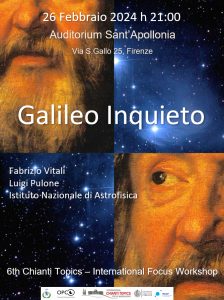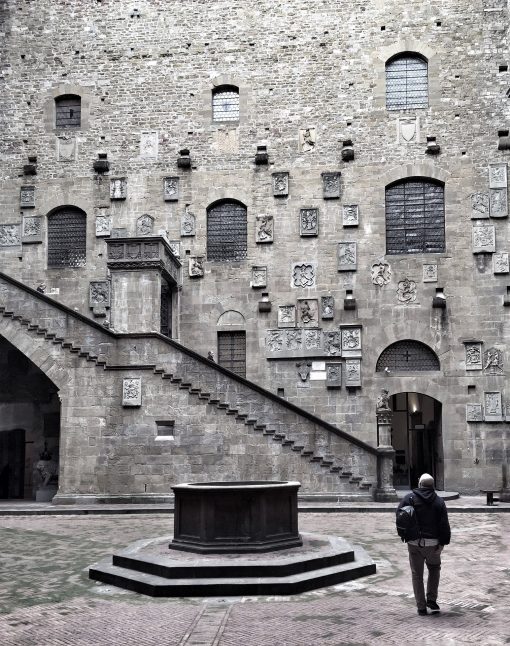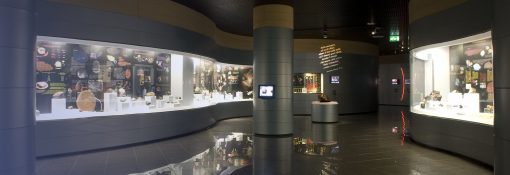WELCOME DRINK
The Welcome Drink on evening 26 February will be offered to the attendees of the 6th Chianti Topics International Focus Workshop and their accompanying persons in the foyer next to the Auditorium. It is a real Chianti experience, a full immersion in the history of Firenze and a tasting tour to discover the food and wine tradition of Chianti. Please, if you wish to join the Welcome Drink, book it at the registration desk upon your arrival. It is included in the conference fee.
GALILEO INQUIETO

The Local Organising Committee welcomes you to this conference show that will be open to the workshop attendees and the generic public. This is in the Santa Apollonia’s Auditorium starting at 9:00 p.m. The show is in Italian.
The work and ingenuity of Galileo Galilei mark the point of no return for modern science: the discoveries he made with the aid of a very simple telescope and the definition of the method of scientific investigation have revolutionized the world of Science forever, not only in the field of Astronomy but in all branches of modern scientific research. Galileo’s drawings, compared with modern images of the Cosmos, testify to the greatness of the astronomer Galileo, his ability to grasp new signs from visions denied, until then, to any man. But this did not happen without problems, his discoveries opened a gap in a thousand-year-old culture, the Earth at the center of the Universe no longer seemed like that unassailable truth, which for 2000 years Aristotle and the Church had seen in perfect agreement. Therefore, Galileo’s story is not only scientific but also human and historical, told through the reading of texts and letters from his long activity as a scientist.
A story that spans the 1600s, a comparison between the past and present of scientific discoveries, a look at the legacy that Galileo Galilei left us, which allowed us to arrive on the Moon and observe, with very powerful instruments, the most remote areas of our Universe and to better understand how they work. The historical, human and scientific story of the father of modern science.
FIRENZE PLANETARIUM

Not far from the Workshop venue, the Florence Planetarium offers visitors a fascinating and astounding look at the entire cosmos. Guided tours are available for who wishes to experience this emotion . The Planetarium entrance is in Via Giuseppe Giusti, from 9:00 a.m. to 17:00 pm. Entrance ticket is 8 euros per person.
SOCIAL DINNER
The workshop attendees will be very welcome at the Social Dinner on February 28th. A full immersion in the Chianti traditional cucine. A unique experience in the ancient Tuscan tradition.
Please, if you wish to join the Social dinner do not hesitate to book it on the registration form or at the registration desk upon your arrival. The cost of 50 Euros is not included in the conference fee.
VISIT OSSERVATORIO POLIFUNZIONALE DEL CHIANTI

View of the Osservatorio Polifunzionale del Chianti (Chianti Observatory)
In the heart of the Chianti hills, near the medieval town of San Donato in Poggio, surrounded by the famous vineyards, the Chianti Botanical Park offers a green oasis where the Osservatorio Polifunzionale del Chianti (OPC) is nestled as pearl. This is a professional observatory, active in research, education and outreach, managed by the University of Florence. Both the Park and the Observatory is offering a great place for researchers and amateurs wishing to study the nature and observe the dark starry vault of cosmos through the largest telescope in Tuscany. It is open to conferences, meetings, lectures, practice for students, but also to tourists and visitors: it is a unique recreational-cultural site, where emotions combine with science and culture.
The workshop attendees and their accompanying persons are very welcome to visit the Observatory for a stargazing evening. Please contact the reception to organize the trip and the visit. Groups are recommended.
VISIT UFFIZI GALLERY MUSEUM
View of the outside of Uffizi Gallery Museum
The Gallery entirely occupies the first and second floors of the large building constructed between 1560 and 1580 and designed by Giorgio Vasari. It is famous worldwide for its outstanding collections of ancient sculptures and paintings (from the Middle Ages to the Modern period). The collections of paintings from the 14th-century and Renaissance period include some absolute masterpieces: Giotto, Simone Martini, Piero della Francesca, Beato Angelico, Filippo Lippi, Botticelli, Mantegna, Correggio, Leonardo, Raffaello, Michelangelo and Caravaggio, in addition to many precious works by European painters (mainly German, Dutch and Flemish).
Moreover, the Gallery boasts an invaluable collection of ancient statues and busts from the Medici family, which adorns the corridors and consists of ancient Roman copies of lost Greek sculptures.
VISIT BARGELLO MUSEUM

Dedicated to Medieval and Renaissance art, the Museo Nazionale del Bargello is located in Florence’s historic Palazzo del Podestà. It was established by royal decree on June 22, 1865—Italy’s first national museum.
From the moment of its foundation, the Bargello’s collection brought together some of the most important works of Renaissance sculpture: masterpieces by Donatello, Luca della Robbia, Andrea del Verrocchio, Michelangelo Buonarroti, and Benvenuto Cellini, drawn largely from the Medici-Granducal collection. Subsequently, the museum’s holdings were enriched with superb examples of bronzes, ceramics, waxes, enamels, medals, ivories, tapestries, seals, and textiles, some from the Medici collections and others from suppressed convents or private collectors. In 1888, Louis Carrand, an antiquarian from Lyon, made one of the most important donations, bequeathing to the Bargello his collection of more than 2.500 paintings and works of decorative art.
A visit to the museum unfolds across the building’s three floors: on the ground floor, visitors may admire the enchanting panorama of the palazzo’s courtyard and the Sala di Michelangelo (Michelangelo Room), filled with sculptures by Michelangelo, Cellini, Giambologna, and Bartolomeo Ammannati.
VISIT PLANETARY SCIENCE MUSEUM

View of Planetary Science Museum
The only Museum in Italy completely dedicated to the planetary sciences offers the possibility to visitors, through meteorites, including the great Nantan meteorite to touch, impact rocks and minerals on display, to make a journey to discover the formation and evolution of our Solar System and planet Earth in particular.
This museum is situated in Prato, near Florence.
VISIT NATURAL HISTORY MUSEUM OF FLORENCE

View of Natural History Museum
It is possible to visit all the museums listed on the site of the Natural History Museum, except the Specola Museum.